
Every year, the prospect of having a full roster of container gardens to plant makes me want to black out. I spend the first three weeks of May utterly certain that I cannot plant one more pot. That I am out of ideas. Luckily, time passes by, and and I start shopping. A client I have worked for as long as this one is easy to shop for. I had a pair of giant banana plants to pick up at our farmer’s market at 5:45 am. I was ready at 7am to let Dan know that we would need two pallets-130 bags – of our custom container soil blend, and 30 bags of bark. We would need moss fabric for a pair of wire urns, and a ladder to tie the mandevillea to the steel plant climbers.
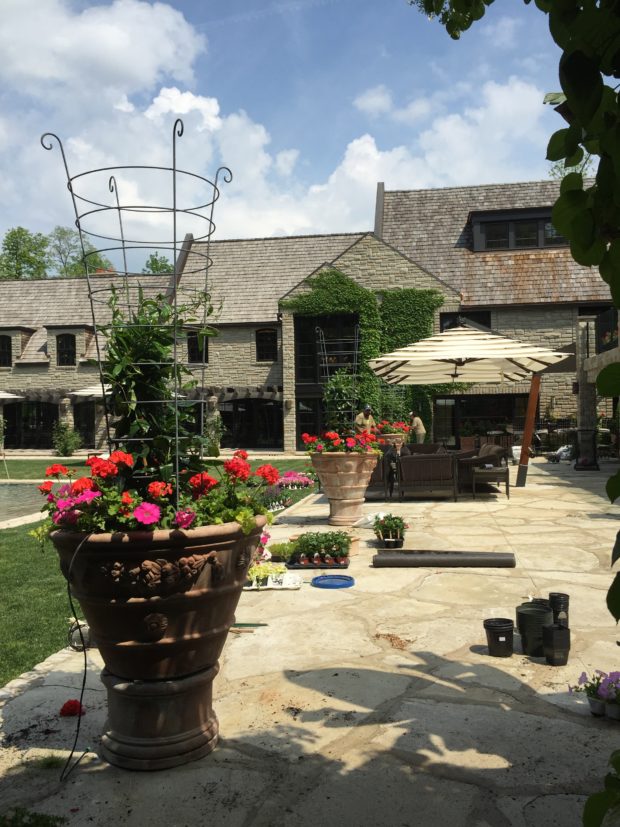 I had shopped with David and Riley on Friday. They put all of our plants on racks, and loaded them onto our trucks. At the end of the day Friday, I was ready in the plant regard. I had an inkling of an idea about what I would plant. Of course I was going over that inkling, critically. I had from 6-8am Saturday morning to print the photographs from last year, and write on them what materials we would use in them this year. Two hours gives me enough time to change my mind. Once my crew is ready to load, I am too. I take extras and alternates, just in case.
I had shopped with David and Riley on Friday. They put all of our plants on racks, and loaded them onto our trucks. At the end of the day Friday, I was ready in the plant regard. I had an inkling of an idea about what I would plant. Of course I was going over that inkling, critically. I had from 6-8am Saturday morning to print the photographs from last year, and write on them what materials we would use in them this year. Two hours gives me enough time to change my mind. Once my crew is ready to load, I am too. I take extras and alternates, just in case.
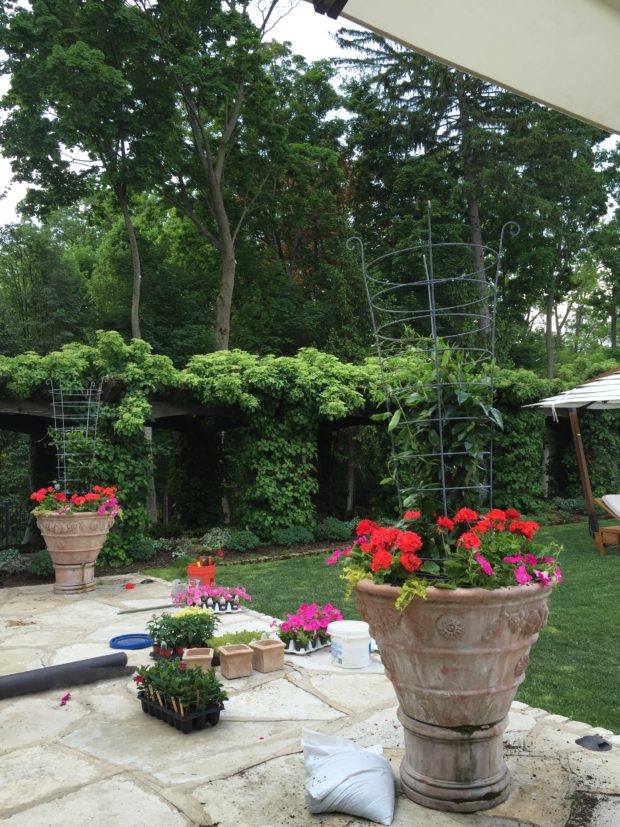 Once every pot had gotten filled with bark for drainage, and our container soil mix, all of the centerpieces get planted. Then I lay out the scheme for the rest of the pot. I was entirely absorbed and focused on how each plant would grow out, and interact with its neighbor. I favor containers that have a beautiful overall shape by the time they mature. My favorite part of this planting for a group of Italian terra cotta pots? Orange geraniums. Geraniums, as they provide an incredible amount of color when properly grown. They are heavy feeders. But more so than the bloom habit, that orange would contribute an interesting variation to a warm color palette. The red mandevilleas and red geraniums are a bluish red. The orange geraniums have just enough yellow to make the combination interesting. My client is keen about the drama that can be created by intense color.
Once every pot had gotten filled with bark for drainage, and our container soil mix, all of the centerpieces get planted. Then I lay out the scheme for the rest of the pot. I was entirely absorbed and focused on how each plant would grow out, and interact with its neighbor. I favor containers that have a beautiful overall shape by the time they mature. My favorite part of this planting for a group of Italian terra cotta pots? Orange geraniums. Geraniums, as they provide an incredible amount of color when properly grown. They are heavy feeders. But more so than the bloom habit, that orange would contribute an interesting variation to a warm color palette. The red mandevilleas and red geraniums are a bluish red. The orange geraniums have just enough yellow to make the combination interesting. My client is keen about the drama that can be created by intense color.
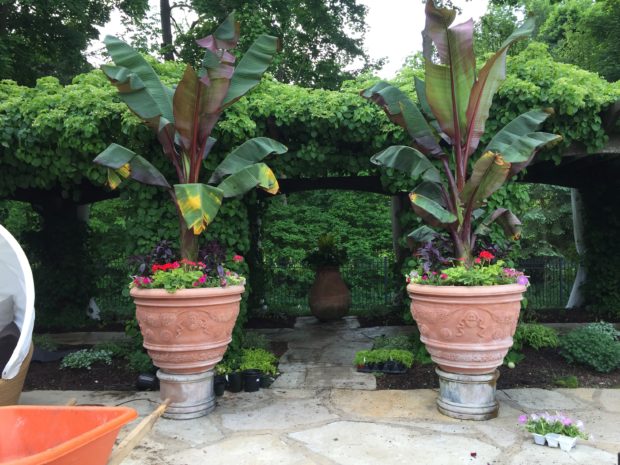 This pair of Italian pots can handle the size and textural drama of a pair of large scale bananas. Not yet visible are a collar of strobilantes, or Persian shield plants that will ring the trunks of the bananas. The chartreuse leaved Persian Queen geraniums and misty lilac waves petunias will highlight the iridescent red-violet of the Persian Shields.
This pair of Italian pots can handle the size and textural drama of a pair of large scale bananas. Not yet visible are a collar of strobilantes, or Persian shield plants that will ring the trunks of the bananas. The chartreuse leaved Persian Queen geraniums and misty lilac waves petunias will highlight the iridescent red-violet of the Persian Shields.
 Lime green is a key color in this planting scheme. All of the warm colors are all the more intense, by their proximity to lime green. The red represented in this container is red sunpatiens. They will grow quite large. The lime licorice will lighten that load of red.
Lime green is a key color in this planting scheme. All of the warm colors are all the more intense, by their proximity to lime green. The red represented in this container is red sunpatiens. They will grow quite large. The lime licorice will lighten that load of red.
 This big scented geranium will have pale pink flowers intermittently over the summer. But they are primarily grown for their bright apple green foliage that can be clipped into shapes. We gave this geranium the most rudimentary clip. My client has a lot of formally trimmed shrubs maintained by the company that prunes our boxwood at the shop. Her crew will put a skilled set of hands to the spherical shape of this geranium. It is under planted with an orange geranium of a different sort than the big growing zonal geraniums. Caliente geraniums come in a wide range of colors, and are extremely easy to grow. The pink and white bicolor trailing verbena “Lanai Twister Pink” is a beautiful addition to this series.
This big scented geranium will have pale pink flowers intermittently over the summer. But they are primarily grown for their bright apple green foliage that can be clipped into shapes. We gave this geranium the most rudimentary clip. My client has a lot of formally trimmed shrubs maintained by the company that prunes our boxwood at the shop. Her crew will put a skilled set of hands to the spherical shape of this geranium. It is under planted with an orange geranium of a different sort than the big growing zonal geraniums. Caliente geraniums come in a wide range of colors, and are extremely easy to grow. The pink and white bicolor trailing verbena “Lanai Twister Pink” is a beautiful addition to this series.
 There are two containers in fairly dense shade. The color of the lime dracaena “Janet Craig” brightens any shady area. The dracaena is under planted with bird’s nest ferns. The leaf form is simialr to the dracaena, but is a darker green.
There are two containers in fairly dense shade. The color of the lime dracaena “Janet Craig” brightens any shady area. The dracaena is under planted with bird’s nest ferns. The leaf form is simialr to the dracaena, but is a darker green.
 A boxwood topiary on standard is under planted with Persian Queen geraniums, red geraniums, and vista fuchsia petunias. The low terra cotta bowl features hot pink XL dahlias, black cherry supertunias, and a bicolor trailing verbena.
A boxwood topiary on standard is under planted with Persian Queen geraniums, red geraniums, and vista fuchsia petunias. The low terra cotta bowl features hot pink XL dahlias, black cherry supertunias, and a bicolor trailing verbena.
 3 terracotta boxes get identical treatment. Hot pink zonal geranium towers, and lime creeping jenny.
3 terracotta boxes get identical treatment. Hot pink zonal geranium towers, and lime creeping jenny.
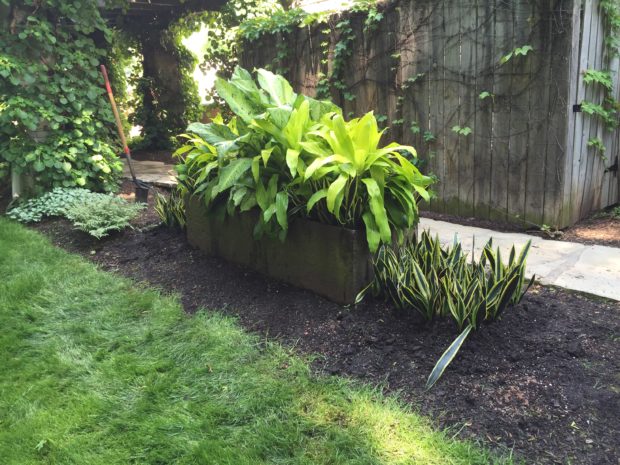 This old cast iron rectangular cauldron sits in a garden bed which is so shady that very little grows there. It is planted with a a pair of lime green fleck leafed dieffenbachia “Camouflage”, Janet Craig dracaenas, and Black Gold Xtreme sansevieria. The sansevieria in the box is repeated in ground at each end. This planting will thrive all summer long with next to no water.
This old cast iron rectangular cauldron sits in a garden bed which is so shady that very little grows there. It is planted with a a pair of lime green fleck leafed dieffenbachia “Camouflage”, Janet Craig dracaenas, and Black Gold Xtreme sansevieria. The sansevieria in the box is repeated in ground at each end. This planting will thrive all summer long with next to no water.
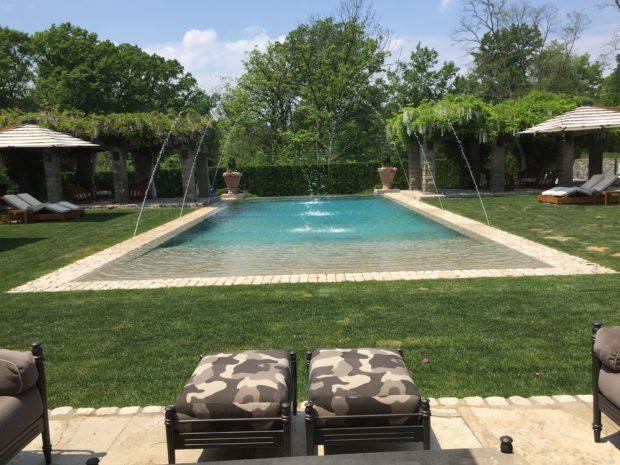 By 2pm, you would never know we had been there. It was a splashy beginning to our container planting season.
By 2pm, you would never know we had been there. It was a splashy beginning to our container planting season.
Beautiful as always! Can you give me advice about keeping my geraniums blooming? I’ve tried different fertilizers but nothing seems to work.
Dear Mary, not knowing your situation, it is hard for me to comment. I grow them in full sun. I water thoroughly and let them dry out between waterings. I feed them regularly. I remove both the flower head and the stem when it is spent. This works for me. You might ask as the grower at a greenhouse near you for advice. best, Deborah
Beautiful! such great ideas for us all! One question -the pot with the narrow opening with the dracena – how do you plant in such a narrow opening – is the pot filled with soil or is it just a smaller pot in the opening? I have a large olive oil jar shaped pot with a 9-10 opening and I’m struggling about how best to plant it. thanks.
Dear Laurie, the Janet Craig has a very big top, compared to the size of the root ball. The birds nest ferns were in 4″ pots. We filled the pots 2/3rds of the way with bark, then landscape fabric, then soil. Best, Deborah
thanks! will try that approach!
What is the name of the beautiful white wisteria in the background of the first picture. Your plantings are phenomenal !
Dear EJ, sorry, I do not know the name. best, Deborah
Deborah, as always, I look forward to your “digging in the dirt” and landscaping posts – all so fabulous! I am curious today in your response above to Laurie with regard to filling the pots 2/3rds with bark & then landscape fabric. Are you referring to a “pine bark mulch” type material & do you use this when planting annuals only or when planting all your containers. I ask this question in particular because I am about to plant hydrangea in ex-large containers and this method would certainly help with drainage and costly potting soil. I am in Zone 8. Many thanks,Vicki
Vicky, I use cedar bark mulch. You want something that does not pack down. Best, Deborah
Tell me about the “geranium towers”, please. How are they planted?
I was going to ask about the geraniums being heavy feeders also. I have read that
if you feed the geraniums, they put out more leaves and less flowers. Apparently, you have not
found that to be true. What fertilizer ration npp do you use please?
Love you blog, thank you!
Dear Glenda, I fertilize my geraniums with osmocote to start. Within a month, I feed every week with a liquid fertilizer mixed at half strength. I dead head the flower and stem religiously. Sometimes I will pinch out some growth tips to promote branching. I do not keep them dry to the point that the leaves wilt. The stress incurred by too dry conditions inhibits growth. In the end, each gardener has to experiment enough to figure out what works for them. The watering and feeding is as much an art asa it is a science. best, Deborah
So inspiring, I love your designs! Question – in one of your photos of geraniums and creeping jenny, you reference a “zonal geranium tower.” What is the tower and do you mind sharing how you build it? Many thanks! Lisa
Dear Lisa, a geranium that is treated with a growth hormone with have elongated stems. The tall, or tower geranium plants are wrapped in a tube of metal fencing to help keep them upright. “Zonal” geraniums have a band of darker red/green on each leaf. best, Deborah
here in zone 5 we are nearly finished filling clients containers and i am barely standing! deborah, your first two sentences resonated more than i can convey.
debra
Boxwood topiary ! Got to find one. I have a pot as large as the one you planted. Can the topiary stay in the pot year round?
Nella, over wintering boxwoods in pots is very difficult. Boxwood topiaries are very expensive, and your chances of losing or burning it in the winter are good. I would dig it up, and plant it in the ground for the winter. best, Deborah
I love your blog. It is such fantastic inspiration. In the container with the lime licorice and red impatiens, what is the narrow green shrub–an arborvitae? If so, do you know the name? Great shape and very narrow–just what I need.
Melissa, this is a lemon cypress. Be sure to look it up to see if it will work for you. They are not hardy in Michigan. best, Deborah
love how the mandevilla towers open up and outward. At the nursery, they come in teepee towers and I always thought they were so messy once they reach the peak of the tower. The wide top must look fantastic full of blooms. Do you sell these towers?
Dear Sophath, we do carry the towers. best, Deborah
Your beautiful pots of designs are very inspiring – especially the green foliage. Thank you very much for sharing…
I always look to you for inspiration for my garden pots. You never fail me! When will you publish a book devoted to container gardening?
I go to you for inspiration too! A few weeks ago I decided to mix up my usual combinations and to plant my beloved flowering tobacco in our front window box. When I googled options – guess what came up – something you planted! I used blue salvia, purple alyssum, and lilac petunias. Can’t wait to get that lovely scent at day’s end, and am already admiring the combination. Thanks Deborah!